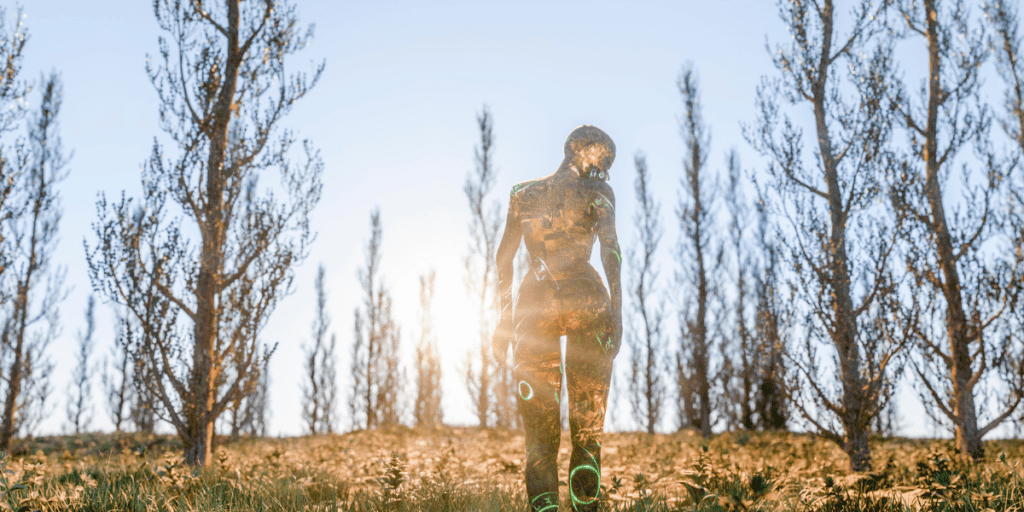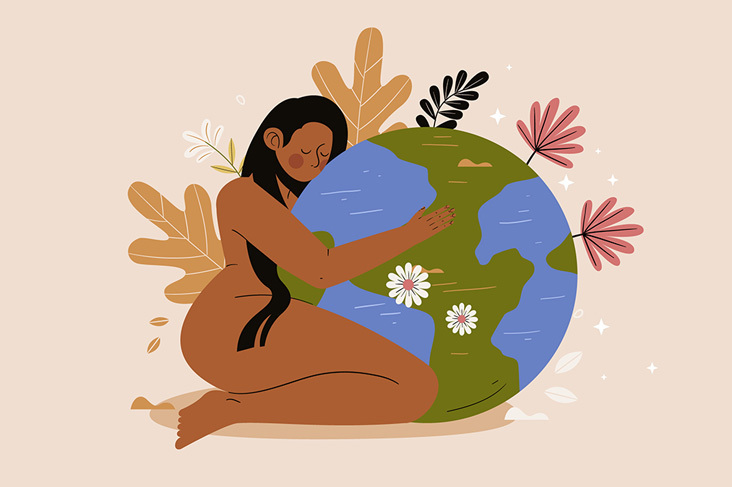Gaea is one of the primordial or “Protogenoi” goddesses in Greek mythology. The primordial gods or goddesses were the first generation gods and goddesses. These primordial gods and goddesses represent the basic elements of the universe, such as the Earth, Air, Sea, Sky, Fresh Water, Underworld, Darkness, Night, Light, Day, Procreation, and Time.

Gaea is the goddess of Earth in Greek mythology. Her Roman equivalent is Tellus. Let’s deep dive into the details.
Origin of Gaea
All primordial deities are believed to have been born out of Chaos. He was the mightiest god of all.
The primordial deities included the Eros (Elder), personifying love and procreation, Tartarus representing the Underworld; Gaea, the Earth goddess or Mother Earth; Erebus, the god personifying darkness; and Nyx, the god of night.
Bonus Read – Who is the Greek God of Darkness? – Dreams and Mythology
According to The Theogony by Hesiod, Gaea originated from the enormous expanse of Chaos. This is the most prevalent story about the birth of Gaea. However, another legend says that Gaea was the child of Hemera, called the Day, and Aether called the Upper Sky or atmosphere.
Hesiod also describes Gaea as the broad-chested, unshakable supreme goddess of all immortals who occupy the peaks of Olympus. She is no ordinary force as she was capable enough to create herself out of Chaos.
Did you know? Goddess Ananke exists beyond space and time and is the goddess of destiny.
Family Tree of Gaea

Gaea is so immensely powerful that without any male partner or husband, she gave birth to 4 children. She bore the sky god Uranus, Pontus, the primordial sea, Nesoi, the goddess of islands, and Ourea, the primordial elemental deity personifying mountains, all on her own.
Once chaos was gone, she created a child who was also her spouse named Uranus. Later, Gaia birthed many gods with Uranus. As the legendary, Hesiod mentions, Gaia, along with Uranus, gave birth to the one-eyed giant, Cyclopes: Brontes (Thunder), Steropes (Lightning), and Arges (Bright). And in the second set of birthing, she was responsible for the origin of the Hecatonchires: Cottus, Briareos, and Gyges.
So, most principal gods and goddesses in Greek mythology can trace their lineage back to Gaea. Pontus and Gaea together birthed many sea gods. Gaea and Uranus also together gave birth to the first generation of divinities called the Titans.
As per Hesiod’s account, she birthed 12 Titans, namely the brothers Oceanus, Coeus, Crius, Hyperion, Lapetus, and Cronus. And the sisters Thea, Rhea, Themis, Mnemosyne, Phoebe, and Tethys. Cronus was the most popular of them all. How and why? You’re about to know more about this. Read on
Famous Myths About Goddess Gaea

Gaea’s son, Cronus, became the ultimate king of Titans after he castrated his father, Uranus.
Here is the account of the famous legend.
Every time a child was born to Gaea, Uranus was extremely jealous of Gaea. He wanted her to dedicate all her attention exclusively to him.
Each giant one-eyed Cyclopes birthed by Gaea had a hundred arms and fifty heads. However, cruel Uranus hid the Cyclopes and Hecatonchires in a secret place one by one as they were born, within Gaia, causing her great pain.
Then Gaia planned an act of revenge against Uranus and convinced her children to help her. As part of the plan, she created a gray flint (or adamantine) that Cronus used to castrate his father, Uranus. And as the arrogant and overconfident Uranus approached Gaia for a sexual relationship to have more children, she severed Uranus’ genitals.
She threw the slaughtered organs or testicles into the sea. Uranus’ semen got spilled and scattered everywhere. And wherever Uranus touched, the newborn nymphs were born.
That’s how Gaia also created the Erinyes, the Giants, and the Meliae (ash-tree nymphs) from the blood of Uranus. Aphrodite was formed from the semen of Uranus and the foam in the sea.
This story repeats itself when Cronus and Rhea give birth to 6 children together: Hestia, Demeter, Hera, Hades, Poseidon, and Zeus. However, Cronos swallowed the first five born children out of jealousy.
Cronus’s reign was very short-lived as his own son Zeus dethroned him after the great battle of the first Olympians versus the Titans. Post this battle, several of the Titans were punished or were cut into pieces to breed throughout the Underworld. As a result of this, Gaea responded by giving birth to a race of giants. They fought against the Olympian gods in the great battle called the Gigantomachy.
The Olympians successfully defeated the Giants with the help of a mortal called Heracles. The primary condition for the Olympian gods to win the battle was to take aid from a mortal. Zeus, Heracles, Poseidon, and Athena fought bravely against the Giants to emerge victorious eventually.
Ultimately, the Olympians prevailed and continued with their never-ending, powerful reign.
Gaia also went on to give birth to the sea-deities Nereus, Thaumas, Phorcys, Ceto, and Eurybia with her son Pontus.
Some other children were born too, including Oceanus, Coeus, Crius, Theia, Rhea, Themis, Mnemosyne, Phoebe, Tethys, the Python of Delphi, and the Titans Hyperion and Iapetus.
Gaia was believed to be an all-encompassing goddess in herself. So, her oath was the most powerful element. It symbolized that nobody could escape from the creator or Mother Earth.
The presence of Gaea is noticeable almost everywhere.
This legend highlights the patriarchy of both Uranus and Cronos. In response to the cruelty committed by Cronos, history repeats itself, and Zeus takes charge to diffuse the situation and free Rhea from the patriarchal clutches of Cronos.
Rhea, however, was clueless about what to do, so she requested Gaea to help. And, when Rhea escapes, to hide baby Zeus in the Cretan or Cavern, fearing Cronos. Gaea lends a helping hand to Rhea to save baby Zeus. Rhea wraps the baby in a stone and hands it over to Cronus. Cronus swallowed, thinking it to be the baby but didn’t realize it was merely a stone.
So, in a nutshell, Gaea is the omnipresent goddess of life, and everything or being that so far exists is because Gaea gave birth to it. She is also the goddess of death, symbolizing that life is a full circle and that everything comes back to the Earth. She has complete authority over a life where she can decide when to end a life or take it back too.
Our planets and the rest of the elements that we need to thrive are all Gaea’s creations.
Relevance or Importance of Gaea in Modern Times
When a natural calamity, disaster, or major catastrophe strikes due to our negligence and disrespect towards the environment, it’s a sign that Mother Earth, Gaea, tries to take it back. She treats us the way we are treating her by destroying her; that is Mother Nature.
In the 1970s, James Lovelock, a British scientist and environmentalist, proposed a theory inspired by Gaea. Let’s look at what it is.
Gaea Hypothesis
According to James Lovelock, our planet Earth is a living, thriving super organism and has been given the name “Gaea or Gaia” to it. He proposes that as a living organism, being or creature living off the resources provided by nature or the Earth, it’s our prime responsibility to respect and take care of it. Because every act of ours has an impact on the environment or nature or Gaea symbolically.
And if we disrespect nature or do not value the environment and the elements that Gaea provides us for our survival. She has every right to take it back or confiscate those resources. And she will eventually, sooner or later, do so if we take nature for granted.
James Lovelock – Originator of Gaia theory and inventor of the electron capture detector, published this theory in a book called “The Gaia.” Not only has he described the Gaea hypothesis in the book in detail. But also, as a notable futurist, he has suggested a way forward for people in the future generations to follow in order to protect our planet.
Verdict
So, Gaea, as the supreme deity or goddess of nature, abundance, life, and every existence on Earth, she’s represented by the planet itself. She even symbolizes other physical elements that form part of the earth: the landscapes, the mountains, the vegetation, the water bodies, the islands, and all other landforms we may not know about.
Another symbol that’s often generally associated with Gaea is the snake or the serpent. In modern times, most people consider reptiles like snakes or serpents a bad omen or have several negative connotations. However, Gaea’s symbolism of a snake or a serpent has a positive sense. And it means renewal.
It represents Gaea’s formidable ability to renew life and pursue living. It also symbolizes protection and security from the fact that serpents or snakes primarily saved the crops or the harvest from rats or rodents.
It’s also believed that the python, the giant serpent killed by Apollo, served Gaea, its mother. Therefore, to summon Gaea as part of any ritual is important in acknowledging that she is omnipresent and accepts and respects her presence in everything around us. It’s your duty to think carefully if you’re treating the natural elements of nature, such as living creatures, plants, and more, the way they should be treated and respected. Gaea teaches you to respect every living, breathing element on earth.
You also might find this interesting – Chronos: Greek God of Time – Dreams and Mythology.
